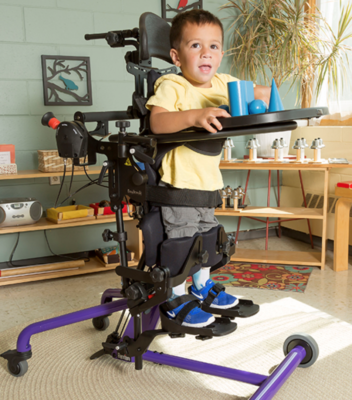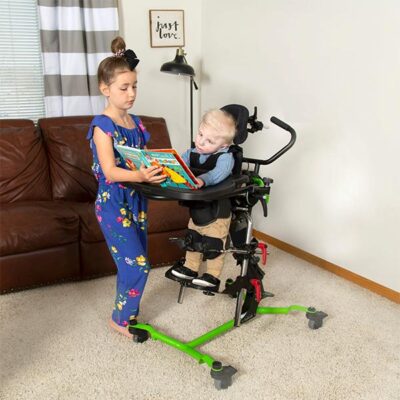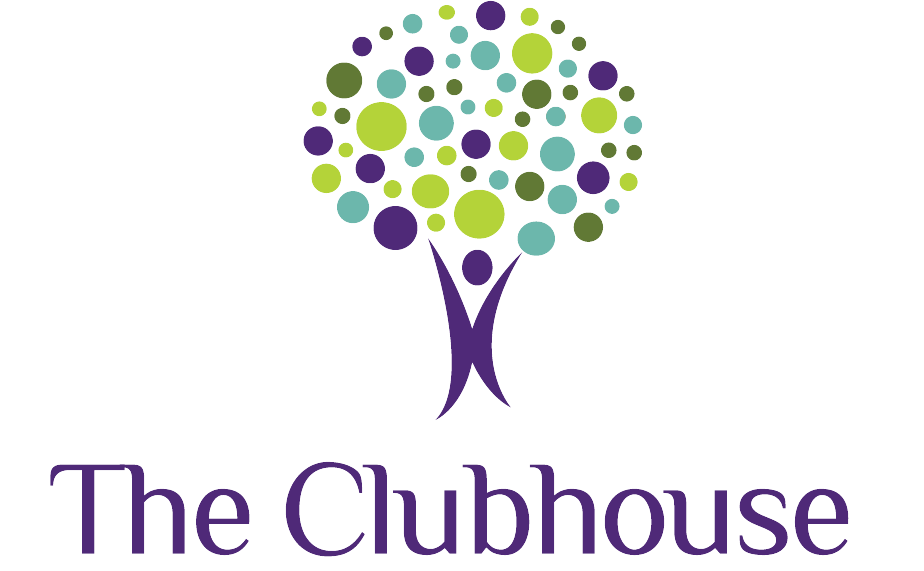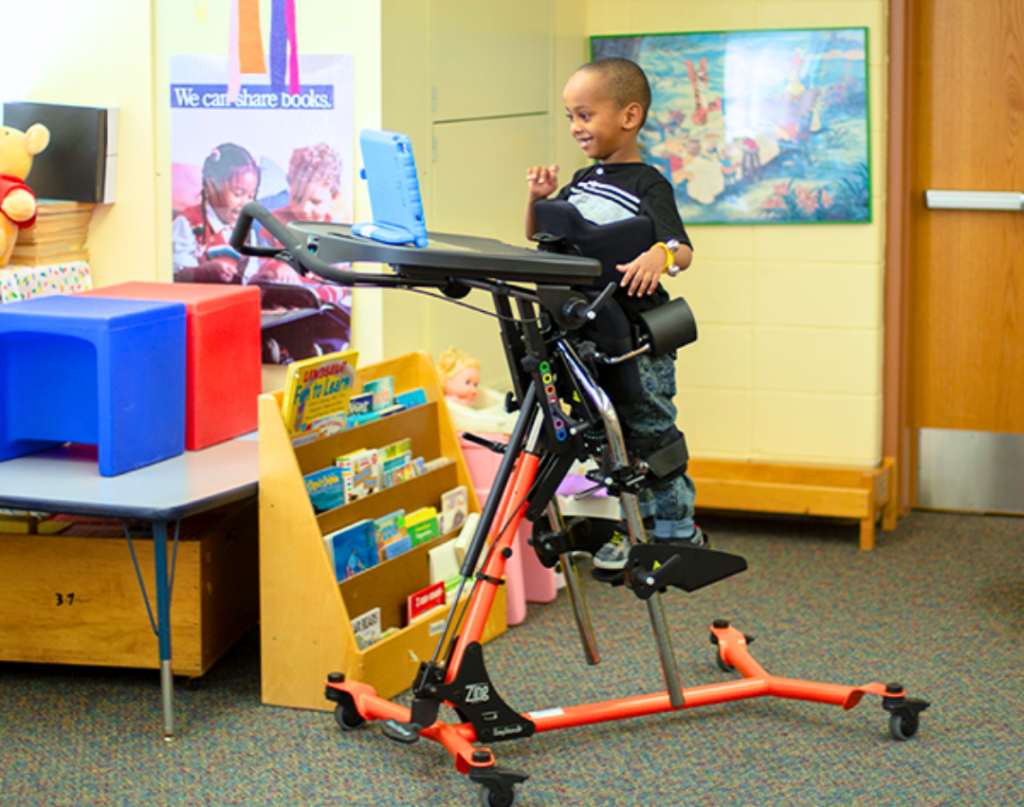What is a standing frame?
A standing frame, or stander, is a type of medical equipment that is used to maintain a patient in an upright, weight-bearing position. It is used to assist a child to stand if they cannot stand on their own or if they need assistance to stand for longer periods of time. Standers usually consist of a metal frame with pads and straps to help secure the individual safely and wheels with locks on the bottom to allow a caregiver to move the device around from one room to another.
Some standers start with the patient in supine (on their back) while others start with the patient in prone (on their tummy). The device can then be raised up or down as needed to adjust the angle of standing/weight-bearing as needed, depending on the user. The device can also be adjusted at various joints (trunk, hips, knees, etc.) to accommodate for the growth of the child.

Who would benefit from a standing frame?
Children who are not active in an upright position, non-ambulatory (cannot walk independently), or minimally ambulatory may all benefit from use of a stander. In general, children with a variety of neurological diagnoses such as cerebral palsy or genetic conditions may benefit from using a stander as part of a daily postural management program.
Keep in mind that children who are otherwise developing their gross motor milestones as expected will typically pull to stand around 9-10 months of age, cruise along furniture, and then eventually walk independently between 12-15 months of age. However, for children with certain developmental diagnoses that impact their ability to weight-bear (stand and walk on their own), a stander can help with ensuring that the child still gets all the benefits of being in an upright position on a daily basis.
For some examples of how to use a standing frame, check out these examples here.

Get Started with Physical Therapy Today
What are the benefits of using a standing frame as part of a postural management program?
There are a wide variety of benefits that a child can gain from using a stander. These can include (but are not limited to) the following:
- Increasing/Maintaining Bone Mineral Density: Bone density is a measure of bone strength. When typically developing children stand and walk in a weight-bearing position, they gain bone density and strength to grow. Standers can help maintain a child in a full weight-bearing position so that they can gain similar benefits to ensure that their skeletal system can grow and develop as strong as possible. Research suggests that using a stander for around 60 minutes/day at least 5 days/week may have a positive impact on bone mineral density.
- Maintaining Skin Integrity: Children who are not able to independently move or re-position themselves are at increased risk of skin breakdown and blistering. Caregivers are key players in positioning and un-weighting sensitive areas of the body that might otherwise be at risk for pressure sores. Using a stander is helpful in taking pressure off of these sensitive areas, especially the sacrum.
- Blood Circulation/Cardiovascular Function: being in an upright weight-bearing position can help improve blood pressure, heart rate, and reduce swelling of the lower extremities. Standers can help achieve this goal when independent standing is not achievable.
- GI Function: use of a stander can help utilize the impact of gravity to aid in digestion and help manage constipation.
- Maintaining Integrity of the Hip Joint: As babies grow and develop, it is the milestones of standing, cruising, and eventually walking independently that help create the necessary level of congruency of the hip joints, leading to more stable hips. Using a stander is a helpful aspect of a hip surveillance program to help prevent dislocation or subluxation. Standers that can further position a child’s hips into adjustable degrees of hip abduction (when the legs move out to the side away from the midline) are favorable with regard to hip joint development.
- Maintaining Joint Range of Motion (ROM) and Reducing Spasticity: Standers can help children with needs to maintain their range of motion and reduce muscle spasticity, which is very common with conditions like cerebral palsy. When neurological conditions lead to muscle tightness, reduced joint ROM, and hypertonia or spasticity of the muscles, a standing frame can be used as one strategy to help manage these symptoms. Standers therefore can also reduce the risk of developing muscle contractures (when muscles become so spastic and tight that they can no longer be lengthened manually and often require surgical intervention to release the tight muscle).
- Psychosocial Benefits, Improved Attention, and Participation: Perhaps one of the greatest benefits of using a stander is the improved self-efficacy the child experiences by being in a prolonged upright position. Children who use a stander to experience the world in a supported standing position often gain confidence, as they are able to experience their world at the same level as siblings, classmates, and other peers/friends. They gain improved attention to tasks, and therefore, improved participation in activities of daily living. They can better concentrate on classroom activities at school. In general, standers help improve a child’s self-awareness and self-esteem as they can access their environment in a different light.
If you think your child would benefit from this type of equipment, or have concerns about their development, please reach out to us today.
Written by Jessica Tarence PT, DPT

